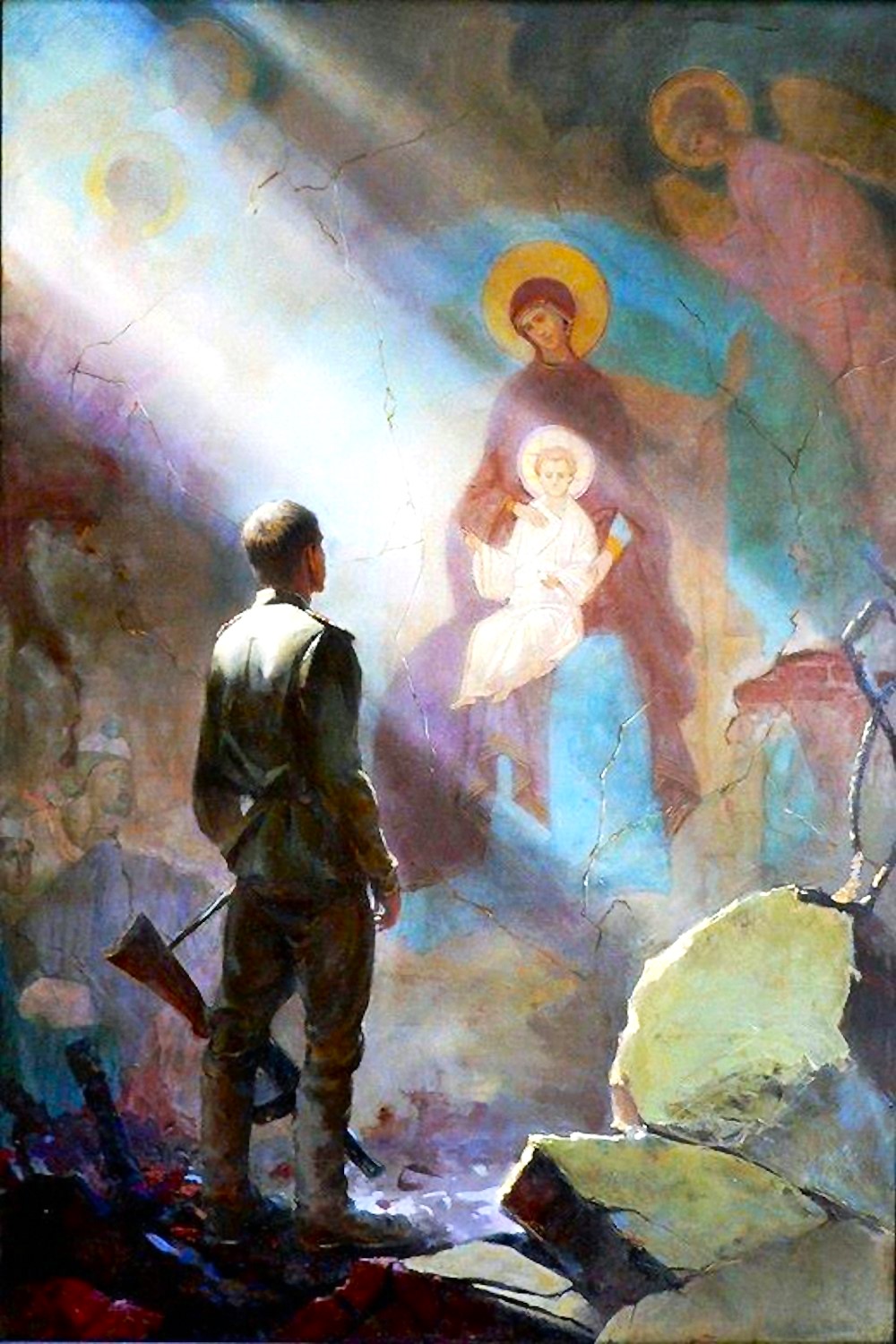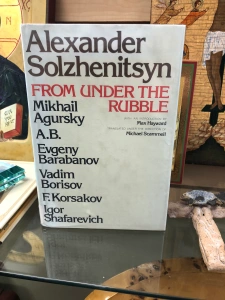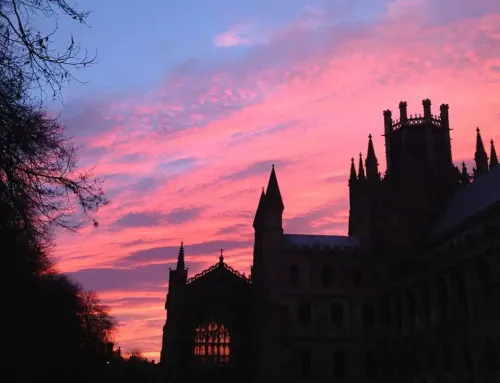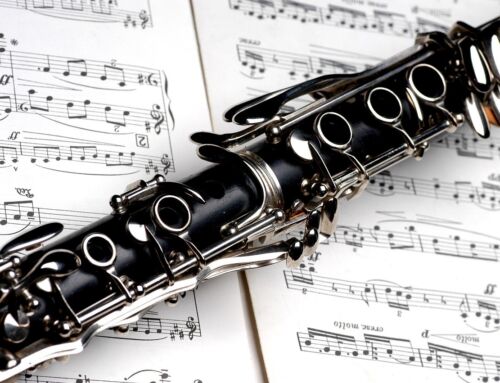The creative genius behind this expressive 2006 painting is amazingly difficult to pin down.
The thousand reproductions of “Faith Under the Rubble” on the Internet identify Yuri Andreyev as the artist, but that name (and several cognates) seems to be as ubiquitous in Russia as “John Smith” in America!
There is a famous Ukrainian engineer from the Chernobyl disaster who goes by the name, as well as a Russian puppeteer, an old Soviet actor, a pop musician, and (at least) two modern artists with the surname Andreyev who are called Yuri Pavlovich and Yuri Alexandrovich respectively. Lacking the ability to research in Russian, I’ll have to defer a final answer to the artist’s identity. Hope springs eternal!

Based on Solzhenitsyn
The absence of data about the artist, however, releases us from the burden of our modern obsession with information and perhaps gives us a little freedom to look at the art itself.
 First, I suspect that the title of the artwork is deliberately chosen. The famous Russian Nobel Prize Winner, Alexander Solzhenitsyn, wrote a series of essays with a few Russian colleagues in 1989 and titled it, From Under the Rubble.
First, I suspect that the title of the artwork is deliberately chosen. The famous Russian Nobel Prize Winner, Alexander Solzhenitsyn, wrote a series of essays with a few Russian colleagues in 1989 and titled it, From Under the Rubble.
In true Solzhenitsyn fashion, the book advocated for the re-establishment of a Christian society based on enduring values rather than on inherently destructive values like violence or materialism.
By the time of the book’s publication, Russian society had been obliterated by Communism for seven decades, so the authors were under no illusion about anti-values values like violence and materialism that degrade society rather than build it up.
It doesn’t seem that Andreyev’s work is a political commentary as much as it is a spiritualized image that takes into account a current sentiment in Eastern Europe and builds on it. The artwork is something of which Solzhenitsyn would have approved: constructive, hopeful, spiritual, and beautiful.
What to Look For
Second, the imagery: “Faith Under the Rubble” is a truly captivating piece of art. Five elements stand out in my mind as significant:
- The rubble. War is inherently destructive, but the physical destruction of war is only the outward sign and, as it were, the fruit of a more frightening inner destruction of moral and spiritual values that leave a society more destitute than physical destruction. The rubble provide a fitting metaphor for the inherently destructive values and sets up a dramatic contrast with the spiritual message.
- The soldier. He is a warrior in uniform, but his rifle is slung down at this side as if he is both physical and emotionally far from removed the battlefield. We catch him at a moment when he seems to be wrapped in contemplation of the magnificent icon on the wall before him that has survived the ravages of war.
- The colors. Destruction and rubble are not the only elements that depress people in a warzone or in degrading urban landscapes. The dismal emptiness and colorlessness of the destroyed environment ruthlessly suck the life out of souls as much as the pain they feel at the destruction of their surroundings. Once again, the bright, attractive colors emphasize the contrast of conflicting values.
- The light. The icon on the wall seems to be a traditional Eastern Christian depiction of the Madonna, and the viewer can’t help noticing the way the rays of light bathe the beautiful image of Mother Mary holding the Christ Child. But notice, also, where the focus of the light falls – on Jesus!
- The angels: One final element that deserves honorable mention, at least, are the three angels on the wall behind Our Lady. You have to look closely to notice them because they seem to fade into the background. They “hover” outside the bluish halo that surrounds the human figures in the foreground, and the two on the left are obscured by the intensity of the beams of light. (Even the soldier’s head and torso are encompassed by that blue halo and partially illuminated by the rays.)
The angels are an integral part of God’s beautiful universe and are deeply involved in the struggle for human salvation. Yet, they always do their work as silent presences, in the background as it were, unless they are sent to have direct contact with men on God’s behalf. Being the only fully spiritual creatures in the scene, enhances the contrast of worldly-spiritual values.
Their very presence, however, seems to spiritualize and lift the broken human reality to a higher plane.
An Icon of an Icon
Regarding those last points, Andreyev has it exactly right. His painting is a sort of icon of an icon, if you think about it.
As Catholics, we insist that these five elements constitute or at least reflect the proper order of things. Our Lady dominates the scene because said that all generations would call her blessed (Lk 1:48). She was the chosen channel through which the Sacred Humanity of the Christ entered the world.
Yet, Mary’s vocation was not just to give birth to Christ in the world of space and time, but also to give birth to Christ in our hearts (this was the main theme of Carryl Houselander’s Marian theology). Christ is the center of all things.
And that seems to be what is happening in “Faith Under the Rubble”, doesn’t it?
We are like the soldier, coming upon the scene unexpectedly and being riveted, for a moment at least, by the spiritual scene breaking into the material devastation. Faith tells us that this is God’s world, and even the degradation of sin and evil doesn’t prohibit Him from inhabiting the world He created.
We come face to face with Our Lady. Mary is holding Jesus out to us so that we can see Him in the full glory of His humanity. She extends the Child to us so that we can embrace Him and take Him into our hearts wherever and whatever the “rubble” happens to be in our lives.
An Artist and a Gift
Andreyev (whoever he is!) is a modern iconographer…and of the best kind.
His artistry and technique are truly wonderful. He depicts a traditional icon on a wall; he splashes the dreary scene with color and light; then he spiritualizes the message by drawing us into the depiction and reminding us of the eternal promises that surpass every human war and problem.
His artistic messaging also does everything good art should do: it opens a sacred window into a new world for his viewers. It lifts us up to breathe the fresh, spiritual air that flows through it to our souls, as it is were reminding us:
“And behold, I am with you always, until the end of the age” (Matt 28:20).

Soul Work
It is true that this vast creation of God’s is, in its own way, a sacred window opening us up to the eternal values of Beauty, Truth, and Goodness, but sacred art especially does this. It is intrinsically consecrated to the purpose of providing a window, an icon, of the sacred that we can see with our eyes in order to be reminded of the higher values that sustain us amid the degradations of our fallen world.
Look around your home, your workplace, your specific room and ask yourself if these spaces are punctuated with sacred icons of divine life. Some people set up little shrines in their homes for sacred objects and art, others just have religious images, devotional objects, and even messages placed throughout their environments as constant reminders of God, His angels, and His saints.
Whatever your style or preference, make sure your respective environments include reminders of the sacred as tangible food for the soul. If you’re lucky enough to find an image with the amazing beauty of “Faith Under the Rubble,” you will never go (spiritually) hungry.



So enlightening and informative.
These sacred windows are teaching me.
Thank you.